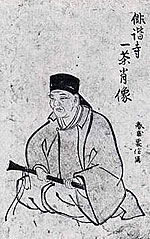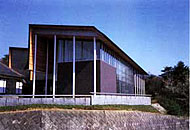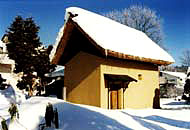 |
 |
 |
| Portrait of Issa by Shunpo Muramatsu |
 |
Ranking right up there with ukiyoe among Japanese art forms beloved by Westerners is the haiku, the spare 17-syllable verse with its evocations of natural beauty and the evanescence of life. Though Matsuo Basho is the most famous of the haiku poets, Kobayashi Issa (1763-1827) may be the more beloved, at least in the West, where his rustic images and pithy commentary on life's vicissitudes enjoy a reputation as being even more "Zenny" than Basho's. Basho may have traveled to the Deep North, but Issa was born and died there -- in the isolated, often snowbound hamlet of Kashiwabara, high on the watershed between what are now Nagano and Niigata Prefectures.
As Kashiwabara's favorite son, Issa statues and monuments -- inscribed with the obligatory verse -- seem to be everywhere. But a haiku pilgrimage is also a nice excuse to take in the other virtues of the region, one of the most spectacularly beautiful in Japan. Now a popular tourist resort with ski runs on every mountain and the lovely lake Nojiri for summer fun, Kashiwabara is no longer isolated but a mere three-hour trip from Tokyo by train or expressway. From Kurohime station or the Shinanomachi interchange it's just a few minutes to the Issa Memorial Hall, which opened in 1960 but moved into an attractive new venue in 2003. Located on a hill next to Issa's grave, it is also close by Issa's family homestead.Though born and raised here, Issa left home at 15 to seek his fortune in Edo, where he lived and honed his haiku skills for many years. It was not until age 51 that he returned to Kashiwabara to marry and move back into the family home, which he shared with his half-brother. Sadly his remaining years were marked by tragedy -- the deaths of wives and children, culminating in his own demise in the storage shed (still standing) where he was forced to live after a fire destroyed his house.
The Issa Memorial Hall features everything you could possibly want to know about Issa, including maps of his travels, a scale model of Kashiwabara as it looked then, and graphics showing the village's rice output, the number of wealthy Issa patrons in each town, and so on. Indeed, much of the museum's appeal is its thorough portrayal of rural life in the Edo era. There are numerous haiku-inscribed scrolls and a pleasant video about Issa and his haunts, but the scenery out the window nearly steals the show. Be sure to take a stroll to Issa's grave and visit the storehouse where he spent his last, no doubt very cold days. This is snow country, and though the roads now remain open all year, the museum does not: closed on November 30, it reopens on April 5.
 |
 |
 |
 |
 |
left: The Issa Memorial Hall
right: The storehouse where Issa died
All images courtesy of the Issa Memorial Hall, Kashiwabara
|
|